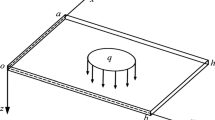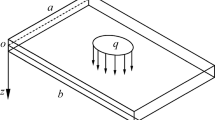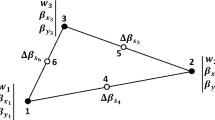Abstract
The reciprocal method of work is used to solve the bending problems of thin plate on elastic foundation under the combined action of lateral loads and forces in middle plane of the plate. The basic system is a simply supported thin plate on elastic foundation under combined action of lateral loads and forces in the middle plane of the plate. Two expressions of the deflection surface equation of the basic system are derived, the first is the double trigonometric function, and the second is the mixture of hyperbolic function and trigonometric function. The practical systems consist of thin plates on elastic foundation constrained by different boundary conditions. The deflection surface equation of the practical system is solved by using the reciprocal method of work between the practical system and the basic system. Compared with the finite element method with ANSYS software, the solution error is less than 5%, which satisfies the requirement of maximum error. This indicates that application of the reciprocal method of work is correct for solving the problem.







Similar content being viewed by others
REFERENCES
R. Li, Y. Zhong, and M. Li, “Analytic bending solutions of free rectangular thin plates resting on elastic foundations by a new symplectic superposition method,” Proc. Roy. Soc. A: Math. Phys. Eng. Sci. 469 (2153), 20120681 (2013). https://doi.org/10.1098/rspa.2012.0681
O. Fergani, I. Lazoglu, A. Mkaddem, et al., “Analytical modeling of residual stress and the induced deflection of a milled thin plate,” Int. J. Adv. Manuf. Technol. 75 (1), 455–463 (2014). https://doi.org/10.1007/s00170-014-6146-3
B. Wang, P. Li, and R. Li, “Symplectic superposition method for new analytic buckling solutions of rectangular thin plates,” Int. J. Mech. Sci. 119, 432–441 (2016). https://doi.org/10.1016/j.ijmecsci.2016.11.006
S. Yang, X. Hua, X. Liu, and C. Li, “Analysis of stability factors of roadway roof and determination of unsupported roof distance,” Shock Vibr. 2021, 2271257 (2021). https://doi.org/10.1155/2021/2271257
O. C. Zienkiewicz and Y. K. Cheung, “The finite element method for analysis of elastic isotropic and orthotropic slabs,” Proc. Inst. Civil Eng. 28 (4), 471–488 (1964). https://doi.org/10.1680/iicep.1964.10014
Y. K. Cheung and O. C. Zinkiewicz, “Plates and tanks on elastic foundations—an application of finite element method,” Int. J. Solids Struct. 1 (4), 451–461 (1965). https://doi.org/10.1016/0020-7683(65)90008-9
A. A. Komlev and S. A. Makeev, “The calculation of rectangular plates on elastic foundation the finite difference method,” Int. J. Phys.: Conf. Ser. 944 (1), 012056 (2018). https://doi.org/10.1088/1742-6596/944/1/012056
G. Bezine, “A new boundary element method for bending of plates on elastic foundations,” Int. J. Solids Struct. 24 (6), 557–565 (1988). https://doi.org/10.1016/0020-7683(88)90057-1
A. El-Zafrany, S. Fadhil, and K. Al-Hosani, “A new fundamental solution for boundary element analysis of thin plates on Winkler foundation,” Int. J. Num. Meth. Eng. 38 (6), 887–903 (1995). https://doi.org/10.1002/nme.1620380602
A. Jahanpour and F. Roozbahani, “An applicable formula for elastic buckling of rectangular plates under biaxial and shear loads,” Aerosp. Sci. Technol. 56, 100–111 (2016). https://doi.org/10.1016/j.ast.2016.07.005
E. Betti, “Teoria della elasticita,” Il Nuovo Cimento (1869–1876), 7 (1), 69–97 (1872).
S. Timoshenko and S. Woinowsky-Krieger, Theory of Plates and Shells (McGraw-Hill, New York, 1959)
M. K. Huang and H. D. Conway, “Bending of a uniformly loaded rectangular plate with two adjacent edges clamped and the others either simply supported or free,” J. Appl. Mech. 19 (4), 451–460 (1952). https://doi.org/10.1115/1.4010542
M. R. Khalili, K. Malekzadeh, and R. K. Mittal, “A new approach to static and dynamic analysis of composite plates with different boundary conditions,” Compos. Struct. 69 (2), 149–155 (2005). https://doi.org/10.1016/j.compstruct.2004.06.006
C. W. Lim and X. S. Xu, “Symplectic elasticity: theory and applications,” Appl. Mech. Rev. 63 (5), 050802 (2010). https://doi.org/10.1115/1.4003700
W. Z. Chien and K. Y. Ye, Elastic Mechanics (Science Press, 1980).
B. L. Fu, “Applications of the reciprocal theorem to solving the equations of the deflection surface of the rectangular plates with various edge conditions,” Appl. Math. Mech. (Eng. Ed.) 3 (3), 353–364 (1982).
B. L. Fu, “Modified theorem of reciprocal works,” J. Yanshan Univ. 029 (003), 189–195 (2005).
B. L. Fu, “Corrected reciprocal theorem of works for bending thin plates and its application,” Appl. Math. Mech. 35 (11), 1197–1209 (2014).
B. L. Fu, “Corrected reciprocal theorem for 3D linear elasticity and its application,” Appl. Math. Mech. 36 (5), 523–538 (2015).
B. L. Fu, “Energy theorems for solving equations of deflections,” Appl. Math. Mech. 2 (6), 697–707 (1981).
Y. B. Zhu and B. L. Fu, “Further research on the bending of the cantilever rectangular plates under a concentrated load,” Appl. Math. Mech. 7 (10), 975–986 (1986).
L. Z. Chen and B. L. Fu, “The bending of thin rectangular plates with mixed supported segments of straight edges,” Appl. Math. Mech. 16 (1), 47–58 (1995).
B. L. Fu and W. F. Tan, “Reciprocal theorem method for solving the problems of bending of thick rectangular plates,” Appl. Math. Mech. 16 (4), 391–403 (1995).
N. Li and S. Mirza, “Buckling analysis of clamped sandwich plates by the reciprocal theorem method,” Comput. Struct. 51 (2), 137–141 (1994). https://doi.org/10.1016/0045-7949(94)90044-2
B. L. Fu and N. Li, “The method of the reciprocal theorem of forced vibration for the elastic thin rectangular plates (III) — Cantilever rectangular plates,” Appl. Math. Mech. 12 (7), 663–680 (1991).
F. F. Zhang, Elastic Plate, 2nd ed. (Science Press, 1984)
Funding
This research was supported by the National Natural Science Foundation of China (No. 51904173), the Shandong Province Higher School Science and Technology Plan Project (No. J18KA307), the Major Scientific and Technological Innovation Projects in Shandong Province (No. 2019SDZY01).
Author information
Authors and Affiliations
Corresponding author
About this article
Cite this article
Li, D., Lu, X., Zhou, L. et al. Reciprocal Method of Work for Solving the Bending of Rectangular Thin Plate on Elastic Foundation under the Combined Action of Lateral Loads and Forces in Middle Plane of the Plate. Mech. Solids 58, 659–669 (2023). https://doi.org/10.3103/S0025654422601744
Received:
Revised:
Accepted:
Published:
Issue Date:
DOI: https://doi.org/10.3103/S0025654422601744




